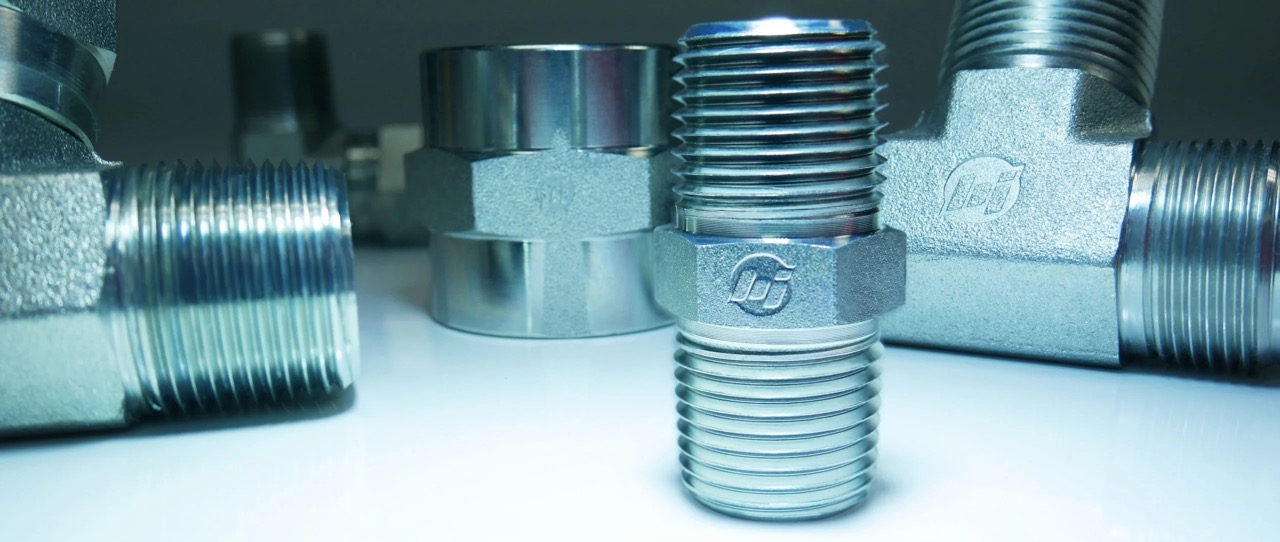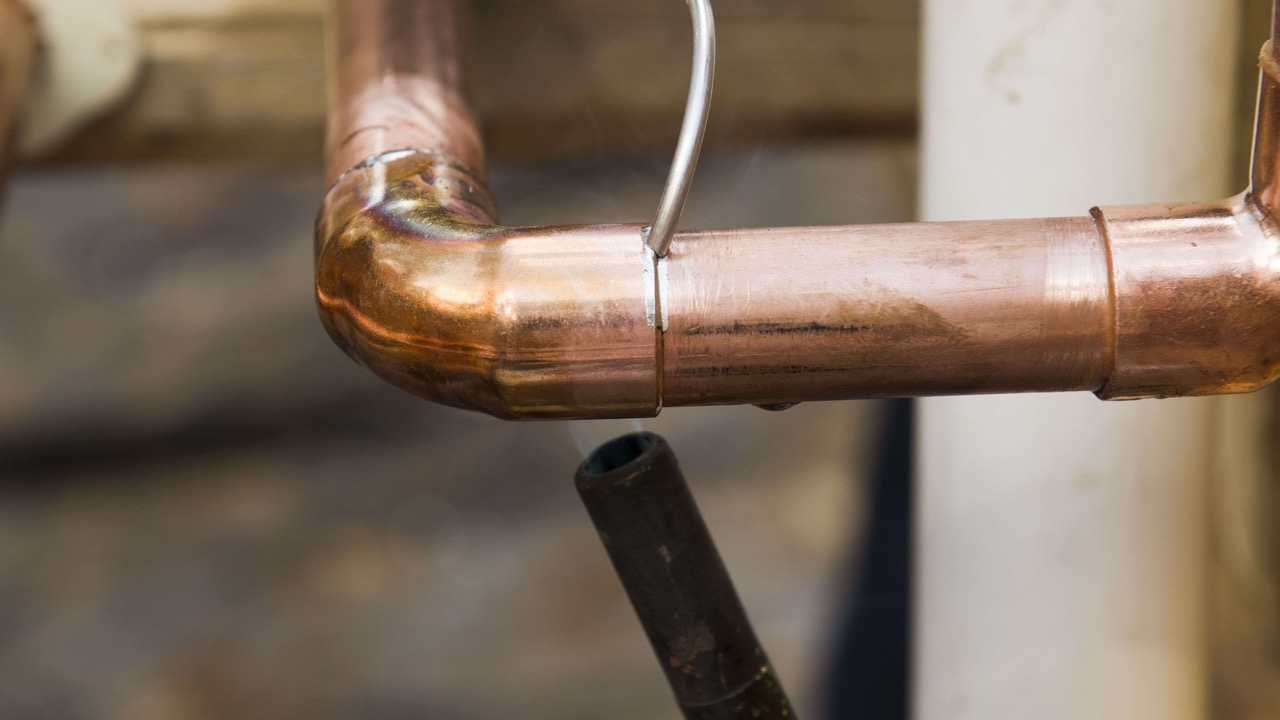

Articles
What Does NPT Stand For Plumbing
Modified: August 28, 2024
Discover what NPT stands for in plumbing with our informative articles. Learn all about this important standard and how it impacts your home's water system.
(Many of the links in this article redirect to a specific reviewed product. Your purchase of these products through affiliate links helps to generate commission for Storables.com, at no extra cost. Learn more)
Introduction
Welcome to the world of plumbing, where an array of terms and acronyms can confuse anyone who is not well-versed in the industry. One common term you might encounter is NPT. Whether you are a homeowner looking to understand your plumbing system better or a professional plumber wanting to expand your knowledge, understanding the meaning and role of NPT is essential.
NPT, which stands for National Pipe Taper, is a commonly used thread standard in plumbing and piping systems. It is widely recognized and used in North America to ensure compatibility and proper sealing between threaded pipe fittings.
But what exactly does NPT mean and how does it apply to plumbing systems? In this article, we will dive into the world of NPT and explore its significance in the plumbing industry. We will discuss its definition, its role in plumbing applications, the advantages and disadvantages of using NPT fittings, and the common applications where NPT is utilized.
So, if you are curious to learn more about NPT and its relevance in plumbing, let’s start unraveling the mysteries behind this abbreviation and discover the fascinating world of NPT fittings!
Key Takeaways:
- NPT, or National Pipe Taper, is a crucial thread standard in plumbing, providing a secure and leak-free connection between fittings. Its tapered design and wide availability make it a reliable choice for various plumbing applications.
- While NPT fittings offer advantages such as ease of installation and resistance to vibration, they require careful attention during installation to prevent potential leakage. Understanding NPT’s significance empowers informed decision-making in plumbing projects.
Read more: What Does TV Stand For In Television
Definition of NPT
NPT, as mentioned earlier, stands for National Pipe Taper. It is a standardized thread form used for pipe fittings, ensuring a secure and leak-free connection. The taper design of NPT threads allows for a tight seal by creating a wedging effect when the male and female threads are joined together.
The taper angle of NPT threads is 1.7899 degrees, which means that as the threads progress, the diameter of the pipe decreases slightly. This taper design allows for a tight fit as the male threads are compressed into the female threads, creating a reliable seal that prevents leaks.
It’s important to note that NPT threads are not straight threads, as the diameter does not remain constant along the length. The taper allows for easy installation and removal of pipe fittings while ensuring a secure connection that can withstand high-pressure environments.
NPT threads are measured in inches and have a nominal pipe size (NPS), which refers to the internal diameter of the pipe. Common NPS sizes for NPT threads include ⅛, ¼, ⅜, ½, ¾, 1, 1 ¼, 1 ½, and 2 inches, among others. It’s essential to match the NPS of the pipe and the fitting accurately to ensure a proper connection.
In addition to the standard NPT, there is also NPTF (National Pipe Taper Fuel), which has modified threads designed for fuel and fluid applications. NPTF threads have a dryseal design, meaning they provide a mechanical seal without the need for sealants or tape.
Now that we have a clear definition of NPT let’s explore its significance in plumbing applications and how it is used in various fittings.
NPT in Plumbing
NPT plays a crucial role in plumbing systems, ensuring secure connections between pipe fittings and preventing leaks. It is commonly used in both residential and commercial plumbing applications. Whether you are installing a new plumbing system, making repairs, or replacing fittings, NPT threads are likely to be encountered.
The tapered design of NPT threads allows for effective sealing of joints, even in environments with high pressure and vibration. The wedging effect created by the taper creates a tight connection that resists loosening and minimizes the risk of leaks.
One of the key benefits of using NPT threads in plumbing is their compatibility with a wide range of fittings. NPT fittings are readily available in various sizes and configurations, making it easier to find the right fitting for any plumbing application. From couplings and elbows to tees and adapters, NPT threads are used in a multitude of fittings to create a reliable and efficient plumbing system.
Moreover, NPT threads are relatively easy to install and remove. The tapered design allows for hand tightening, eliminating the need for special tools in most cases. This makes NPT fittings ideal for both professional plumbers and DIY enthusiasts, as they offer flexibility and ease of use.
However, it’s crucial to note that NPT fittings should be properly installed to ensure a secure and leak-free connection. Over-tightening can damage the threads, while under-tightening may result in leaks. Applying a suitable thread sealant, such as Teflon tape or pipe dope, is often recommended to enhance sealing and prevent leaks when installing NPT fittings.
Overall, NPT threads are a widely adopted standard in the plumbing industry due to their reliability, versatility, and compatibility. From residential plumbing systems to commercial applications, NPT fittings provide a trusted solution for creating secure connections and maintaining the integrity of plumbing systems.
Next, let’s explore the different types of NPT fittings commonly used in plumbing.
NPT Fittings
NPT fittings are a key component of plumbing systems, allowing for the connection and direction of pipes in a variety of configurations. These fittings are designed with NPT threads, ensuring a tight and leak-free seal between the pipes.
There is a wide range of NPT fittings available in the market, catering to different plumbing needs and applications. Here are some of the most common types of NPT fittings:
- Couplings: Couplings are used to connect two pipes of the same diameter and provide a straight connection. They feature female NPT threads on both ends, allowing for a secure and straight joining of pipes.
- Elbows: Elbows are fittings with a 90-degree or 45-degree bend, allowing for changes in direction in plumbing systems. They are available with both male and female threads, providing flexibility in connecting pipes or other fittings at various angles.
- Tees: Tees are fittings that create a T-shaped connection between three pipes. They feature a female NPT thread on one end and two male NPT threads on the other ends, allowing for the distribution of fluid or gas in different directions.
- Adapters: Adapters, also known as bushings or reducers, are used to connect pipes of different diameters. They have a female NPT thread on one end and a male NPT thread on the other, allowing for a secure connection between pipes of different sizes.
- Caps and Plugs: Caps are used to seal the end of a pipe, while plugs are used to seal an unused opening in a fitting or valve. They feature male NPT threads and provide a tight closure, preventing the flow of liquid or gas.
These are just a few examples of the common NPT fittings used in plumbing systems. However, there are many more variations available, including crosses, unions, nipples, and more. The type of fitting used depends on the specific requirements of the plumbing installation and the desired configuration.
When selecting NPT fittings, it’s essential to consider factors such as the material of the fitting, the compatibility with the pipe material, and the pressure and temperature ratings. This ensures that the chosen NPT fittings are suitable for the intended application and can withstand the demands of the plumbing system.
Now that we have explored the different types of NPT fittings, let’s move on to the installation process and the advantages of using NPT fittings in plumbing.
Installation of NPT Fittings
Installing NPT fittings requires careful attention to ensure a proper, leak-free connection. Here are the steps involved in the installation process:
- Prepare the pipe: Start by preparing the pipe ends that will be joined with NPT fittings. Ensure that the ends of the pipes are smooth, clean, and free from debris or burrs. This will help create a secure seal and prevent leaks.
- Apply thread sealant: To enhance the sealing capabilities of NPT fittings, it is recommended to apply a suitable thread sealant to the male threads. Teflon tape or pipe dope can be used for this purpose. Wrap the tape or apply the pipe dope in the direction of the threads, covering the entire threaded portion.
- Hand tighten: Begin the installation by hand tightening the NPT fitting onto the prepared pipe. Start by aligning the threads and turning the fitting clockwise. Use a wrench or pliers to continue tightening until the fitting is snug on the pipe.
- Check alignment: After hand tightening, check the alignment of the fitting. Make sure it is properly aligned with the desired direction of the pipe or fitting configuration. Adjust if necessary before proceeding to the final tightening stage.
- Final tightening: Using a wrench or pliers, carefully tighten the NPT fitting to its final position. Be mindful not to over-tighten, as this can damage the threads or cause leaks. The goal is to achieve a tight and secure connection that will withstand pressure and vibration.
- Inspect for leaks: Once the NPT fitting is securely tightened, inspect the connection for any signs of leakage. Apply pressure to the system, if applicable, and check all joints for moisture or escaping fluid. If there are any leaks, adjust the fitting accordingly.
It’s important to note that NPT fittings should not be loosened and re-tightened repeatedly, as this can compromise their sealing capabilities over time. If adjustments are necessary, it is recommended to replace the fitting or consult a professional plumber for assistance.
Now that we understand the installation process, let’s explore the advantages of using NPT fittings in plumbing systems.
NPT stands for National Pipe Thread, a standard for tapered threads used in plumbing fittings and pipes. When working with NPT fittings, use thread sealant to prevent leaks.
Read more: What Does TCL TV Stand For
Advantages of NPT Fittings
NPT fittings offer several advantages that make them a preferred choice in plumbing systems. Here are some of the key advantages of using NPT fittings:
- Secure and reliable connection: The tapered design of NPT threads enables a tight and secure connection between pipe fittings. The wedging effect created by the taper ensures a reliable seal that can withstand high-pressure environments and minimize the risk of leaks.
- Wide availability: NPT fittings are widely available in various sizes, configurations, and materials. This makes it easier to find the right fitting for any plumbing application, whether it’s for residential, commercial, or industrial use.
- Versatility: NPT threads can be used with a wide range of materials, such as brass, stainless steel, copper, and PVC. This versatility allows for compatibility with different pipe materials and expands the options for plumbing installations.
- Easy installation: NPT fittings are relatively easy to install, especially for those with basic plumbing knowledge. The tapered design allows for hand tightening in most cases, eliminating the need for specialized tools. This makes NPT fittings a convenient choice for both professional plumbers and DIY enthusiasts.
- Resistance to vibration: The tapered design of NPT threads provides resistance to vibration, which is beneficial in plumbing systems where pipes may encounter movement or vibrations. This resistance helps maintain a secure connection and prevents loosening over time.
- Cost-effective: NPT fittings are typically cost-effective compared to other thread standards. Their wide availability and compatibility with various materials contribute to their affordability, making them a popular choice for plumbing installations.
These advantages demonstrate why NPT fittings are widely used in plumbing systems. Their secure connection, versatility, ease of installation, and cost-effectiveness make them a reliable choice for various plumbing applications.
However, it’s important to consider the potential disadvantages of using NPT fittings as well. Let’s explore some of the drawbacks in the next section.
Disadvantages of NPT Fittings
While NPT fittings offer numerous advantages, they do have some drawbacks that should be considered when using them in plumbing systems. Here are a few disadvantages of NPT fittings:
- Sealing may require additional steps: Although NPT fittings are designed to create a tight seal, additional steps are often necessary to ensure a leak-free connection. Applying a thread sealant, such as Teflon tape or pipe dope, is recommended to enhance the sealing capabilities. While these steps are relatively simple, they do add an extra layer of preparation and time to the installation process.
- Potential for leakage: Despite efforts to ensure a proper seal, there is still a possibility of leaks with NPT fittings. The taper design relies on the compression of the male threads into the female threads to create a seal. If the fitting is not tightened adequately or if there are imperfections in the threads, leaks can occur. Regular inspections and maintenance are needed to address any potential leakage issues.
- Not suitable for certain applications: NPT fittings may not be suitable for all plumbing applications. In situations where a high level of sealing integrity is required, such as in gas or fluid transportation systems, other thread standards or specialized fittings may be preferred. It’s important to assess the specific requirements of the plumbing project and consult industry guidelines or professionals when considering NPT fittings.
- Compatibility with limited thread standards: While NPT is commonly used in North America, it may not be compatible with thread standards used in other regions. If you are working on an international project or dealing with imported fittings, it’s important to ensure compatibility and consider alternative thread standards if necessary.
Despite these disadvantages, NPT fittings continue to be widely used in plumbing systems due to their reliability, availability, and cost-effectiveness. Understanding the limitations of NPT fittings allows for proper consideration and informed decision-making when selecting fittings for a plumbing project.
Next, let’s explore some common applications where NPT is utilized in plumbing systems.
Common Applications of NPT in Plumbing
NPT fittings are deployed in a wide range of plumbing applications due to their versatility and compatibility with various materials. Here are some common applications where NPT is utilized:
- Residential Plumbing: NPT fittings are commonly used in residential plumbing systems for installations such as sinks, showers, toilets, and water heaters. They provide secure connections between pipes, ensuring the proper flow of water and preventing leaks.
- Commercial Plumbing: NPT fittings are also prevalent in commercial plumbing applications, including office spaces, restaurants, hotels, and retail stores. They are used in installations such as faucets, water supply lines, and drainage systems, providing reliable connections and ensuring efficient water flow.
- Industrial Plumbing: In industrial settings, NPT fittings are used for various purposes, such as connecting pipes in manufacturing facilities, factories, and processing plants. They are ideal for handling materials like water, gas, oils, chemicals, and other fluids commonly found in industrial environments.
- Hydronic Heating Systems: NPT fittings are utilized in hydronic heating systems, which involve the circulation of hot water or steam to provide heating. They are used in connecting radiators, boilers, pumps, and other components of the system, ensuring a secure and reliable flow of heated water or steam.
- Agricultural Irrigation: NPT fittings are widely used in agricultural irrigation systems that require efficient water distribution. They are used in connecting pipes, valves, sprinklers, and other irrigation components, enabling the proper flow of water to irrigate crops effectively.
- Mechanical Systems: NPT fittings have extensive applications in mechanical systems, such as air conditioning, refrigeration, and ventilation systems. They are used in connecting pipes, valves, compressors, and other components, allowing for the proper circulation and control of air or refrigerant.
These are just a few examples of the common applications where NPT fittings are utilized in plumbing. Through their compatibility, reliability, and ease of installation, NPT fittings provide the necessary connections to ensure the smooth operation of plumbing systems across various industries and settings.
Now, let’s conclude our exploration of NPT and its significance in plumbing systems.
Conclusion
In conclusion, NPT (National Pipe Taper) is a widely recognized thread standard in the plumbing industry. It offers several advantages that make it a popular choice for plumbing applications, including its secure and reliable connection, wide availability, versatility, ease of installation, and cost-effectiveness. NPT fittings play a vital role in creating leak-free connections between pipes and providing the necessary flexibility to accommodate different configurations.
While NPT fittings have their advantages, it’s important to be aware of their potential drawbacks, such as the need for additional sealing steps and the potential for leakage if not installed properly. Careful attention must be paid during the installation process to ensure a secure and tight connection.
Common applications of NPT fittings range from residential and commercial plumbing to industrial settings and agricultural irrigation. They are used to connect pipes, valves, and other components, allowing for the efficient flow of fluids and maintaining the integrity of plumbing systems.
Understanding NPT and its significance in plumbing systems can empower homeowners and professionals alike to make informed decisions when it comes to selecting fittings and ensuring the proper installation of plumbing systems. Whether you are embarking on a DIY plumbing project or relying on the expertise of a professional plumber, knowledge of NPT and its applications can contribute to a successful and reliable plumbing system.
So, the next time you encounter NPT fittings in your plumbing endeavors, you can now appreciate their importance and make confident choices in creating a well-functioning and leak-free plumbing system.
Frequently Asked Questions about What Does NPT Stand For Plumbing
Was this page helpful?
At Storables.com, we guarantee accurate and reliable information. Our content, validated by Expert Board Contributors, is crafted following stringent Editorial Policies. We're committed to providing you with well-researched, expert-backed insights for all your informational needs.















0 thoughts on “What Does NPT Stand For Plumbing”